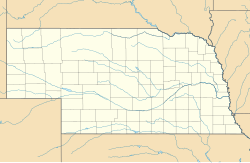Meridian Highway Bridge | |
|---|---|
 Meridian Bridge as seen from Yankton trail. | |
| Coordinates | 42°51′53″N97°23′38″W / 42.8646°N 97.394°W |
| Carries | pedestrians, previously 2 lanes of |
| Crosses | Missouri River |
| Locale | Yankton, South Dakota and Cedar County, Nebraska |
| Official name | Meridian Highway Bridge |
| Maintained by | City of Yankton, South Dakota |
| Characteristics | |
| Design | Vertical lift bridge double deck, Pratt through truss |
| Total length | 3,013 feet |
| Width | 33 feet |
| Longest span | 1,668 feet |
| Clearance below | feet |
| History | |
| Opened | 1924 |
Meridian Bridge | |
| Nearest city | South Yankton, Nebraska |
| Coordinates | 42°51′52.47″N97°23′38.31″W / 42.8645750°N 97.3939750°W |
| Area | 2.4 acres (0.97 ha) |
| Architectural style | Prat vertical-lift truss |
| MPS | Highway Bridges in Nebraska MPS |
| NRHP reference No. | 93000537 [1] |
| Added to NRHP | June 17, 1993 |
| Location | |
 | |
The Meridian Highway Bridge is a bridge that formerly carried U.S. Route 81 across the Missouri River between Nebraska and South Dakota. The Meridian Highway Bridge connects Yankton, South Dakota with rural Cedar County, Nebraska. The Meridian Bridge is a double-deck bridge, with the top level having carried traffic into South Dakota from Nebraska, and the lower level having carried traffic into Nebraska from South Dakota. It was closed to all traffic in 2008, but reopened for use only by pedestrians and bicycles in 2011.

